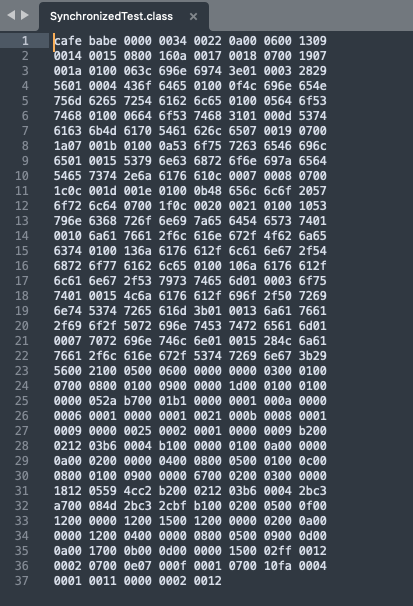Synchronized的实现原理
Synchronized的实现原理
1. 简介
synchronized,是Java中用于解决并发情况下数据同步访问的一个很重要的关键字。当我们想要保证一个共享资源在同一时间只会被一个线程访问到时,我们可以在代码中使用synchronized关键字对类或者对象加锁。
那么synchronized关键字的实现原理是什么呢?
2. 准备工作(反编译)
2.1 源代码
public class SynchronizedTest {
public synchronized void doSth(){
System.out.println("Hello World");
}
public void doSth1(){
synchronized (SynchronizedTest.class){
System.out.println("Hello World");
}
}
}
2.2 编译 javac
javac SynchronizedTest.java
我们可以看到编译出来的class 代码我们是无法直接阅读的二进制文件

2.3 反编译javap
javap -c SynchronizedTest
编译出的结果
Compiled from "SynchronizedTest.java"
public class SynchronizedTest {
public SynchronizedTest();
Code:
0: aload_0
1: invokespecial #1 // Method java/lang/Object."<init>":()V
4: return
public synchronized void doSth();
Code:
0: getstatic #2 // Field java/lang/System.out:Ljava/io/PrintStream;
3: ldc #3 // String Hello World
5: invokevirtual #4 // Method java/io/PrintStream.println:(Ljava/lang/String;)V
8: return
public void doSth1();
Code:
0: ldc #5 // class SynchronizedTest
2: dup
3: astore_1
4: monitorenter
5: getstatic #2 // Field java/lang/System.out:Ljava/io/PrintStream;
8: ldc #3 // String Hello World
10: invokevirtual #4 // Method java/io/PrintStream.println:(Ljava/lang/String;)V
13: aload_1
14: monitorexit
15: goto 23
18: astore_2
19: aload_1
20: monitorexit
21: aload_2
22: athrow
23: return
Exception table:
from to target type
5 15 18 any
18 21 18 any
}
3. 原理
反编译 后,我们可以看到Java编译器为我们生成的字节码。在对于doSth和doSth1的处理上稍有不同。也就是说。JVM对于同步方法和同步代码块的处理方式不同。
- 同步方法:JVM采用
ACC_SYNCHRONIZED标记符来实现同步 - 同步代码块:JVM采用
monitorenter、monitorexit两个指令来实现同步。
3.1 同步方法
The Java® Virtual Machine Specification中有关于方法级同步的介绍:
Method-level synchronization is performed implicitly, as part of method invocation and return. A synchronized method is distinguished in the run-time constant pool’s method_info structure by the ACC_SYNCHRONIZED flag, which is checked by the method invocation instructions. When invoking a method for which ACC_SYNCHRONIZED is set, the executing thread enters a monitor, invokes the method itself, and exits the monitor whether the method invocation completes normally or abruptly. During the time the executing thread owns the monitor, no other thread may enter it. If an exception is thrown during invocation of the synchronized method and the synchronized method does not handle the exception, the monitor for the method is automatically exited before the exception is rethrown out of the synchronized method.
主要说的是: 方法级的同步是隐式的。
- 同步方法的常量池中会有一个
ACC_SYNCHRONIZED标志。 - 当某个线程要访问某个方法的时候,会检查是否有
ACC_SYNCHRONIZED,如果有设置,则需要先获得监视器锁,然后开始执行方法,方法执行之后再释放监视器锁。 - 这时如果其他线程来请求执行方法,会因为无法获得监视器锁而被阻断住。
- 值得注意的是,如果在方法执行过程中,发生了异常,并且方法内部并没有处理该异常,那么在异常被抛到方法外面之前监视器锁会被自动释放。
3.2 同步代码块
同步代码块使用monitorenter和monitorexit两个指令实现。 The Java® Virtual Machine Specification 中有关于这两个指令的介绍:
monitorenter
Each object is associated with a monitor. A monitor is locked if and only if it has an owner. The thread that executes monitorenter attempts to gain ownership of the monitor associated with objectref, as follows:
If the entry count of the monitor associated with objectref is zero, the thread enters the monitor and sets its entry count to one. The thread is then the owner of the monitor.
If the thread already owns the monitor associated with objectref, it reenters the monitor, incrementing its entry count.
If another thread already owns the monitor associated with objectref, the thread blocks until the monitor’s entry count is zero, then tries again to gain ownership.
monitorexit
The thread that executes monitorexit must be the owner of the monitor associated with the instance referenced by objectref.
The thread decrements the entry count of the monitor associated with objectref. If as a result the value of the entry count is zero, the thread exits the monitor and is no longer its owner. Other threads that are blocking to enter the monitor are allowed to attempt to do so.
大致内容如下:
- 可以把执行
monitorenter指令理解为加锁,执行monitorexit理解为释放锁。 - 每个对象维护着一个记录着被锁次数的计数器。未被锁定的对象的该计数器为0,当一个线程获得锁(执行
monitorenter)后,该计数器自增变为 1 ,当同一个线程再次获得该对象的锁的时候,计数器再次自增。 - 当同一个线程释放锁(执行
monitorexit指令)的时候,计数器再自减。 - 当计数器为0的时候。锁将被释放,其他线程便可以获得锁。
4. 总结
同步方法通过
ACC_SYNCHRONIZED关键字隐式的对方法进行加锁。当线程要执行的方法被标注上ACC_SYNCHRONIZED时,需要先获得锁才能执行该方法。同步代码块通过
monitorenter和monitorexit执行来进行加锁。当线程执行到monitorenter的时候要先获得所锁,才能执行后面的方法。当线程执行到monitorexit的时候则要释放锁。每个对象自身维护这一个被加锁次数的计数器,当计数器数字为0时表示可以被任意线程获得锁。当计数器不为0时,只有获得锁的线程才能再次获得锁。即可重入锁。